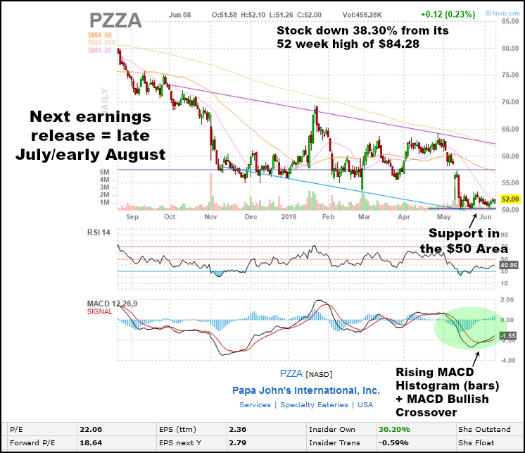Technical Analysis and Selling Puts
Using Basic Technical Analysis to Time Trade Entries and Intelligently Manage a Position

My teacher way back in 5th grade was Mrs. Paul.
Mrs. Paul wore these really thick, coke bottle glasses and was probably not that far from being legally blind.
She herself had grown up in Kansas and I've always remembered two stories she told about Kansas and about her childhood.
The first was that everything was so flat and straight in Kansas that you could drive miles without ever moving your steering wheel (that may have been a slight exaggeration).
The second involved her poor eyesight.
She wasn't diagnosed as being severely nearsighted and didn't get her first pair of glasses until she was eight years old.
Up until that point, she said, she never realized that trees had leaves.
When it comes to trading - options or stocks - how many investors are missing out on what's right in front of them?
Stocks have charts, and charts leave little fluttering clues about which way the wind is blowing.
And knowing which way the wind is blowing is most of the battle when it comes to success in the stock market (and in most other areas of life, too).
Today I'd like to share a Leveraged Investing Club trade that really illustrates what I'm talking about.
Basic technical analysis - the coke bottle glasses that can instantly transform our market perceptions and insights - enabled us to make smart and informed choices every step of the way on what ended up being a challenging trade.
Basic Technicals Helped Us decide:
- When to enter this trade
- When to hold steady and not panic when a totally out of the blue crisis emerged
- When to finally exit (and for fantastic returns)
The trade in question was a short put position on PZZA (Papa John's Pizza) that we'd entered back in mid-June 2018.
The case for selling puts at the $50 strike was largely technical.
We also factor in valuation and fundamentals.
But in this case, the company had been struggling some on the sales front and, while not overvalued, the shares weren't dirt cheap either.
The stock had sold off, however, following the previous earnings release, but then eventually found renewed support in the $50 area.
Here's the chart I posted inside the Leveraged Investing Club at the time that gives a quick visual rationale for the trade.
Plus we'd already successfully sold puts on PZZA on a couple other occasions earlier in the year:
>> A single FEB 16 2018 $55 SHORT PUT that I exited early and which trade produced 44.05% annualized returns over 15 days
>> A single APR 20 2018 $55 SHORT PUT that I exited early again for 22.93% annualized returns over 32 days
Please - take a couple seconds to check out the chart (you can click on it for a larger view).
- There's clearly technical support in the $50 area
- And the MACD and MACD Histogram were both providing a confirmation that the $50 support level was solid and holding
These were the basic technical analysis leaves on the tree showing me very clearly which way the wind was blowing.
When you know what to look for, finding high quality, high probability, safe, and lucrative trades is neither hard nor all that mysterious.
(The trick is having an efficient process to sort through and review a large number of stocks.)
Here's Point #1 - basic technical analysis helped me identify a great put selling trade in advance - and to get the timing right for when to enter that trade.
Basic Technicals also helped me manage the trade when a totally out of the blue crisis emerged afterwards.
That's Point #2.
For the first three weeks or so, the trade went according to plan.
The stock had its days of weakness, but it never dropped below $50 (although it came close a couple of times), but each time it would bounce a little higher again.
And then - holy crap! - this happened with about a week and a half to go until expiration:
Papa John's Founder Used N-Word On Conference Call
The stock immediately fell more than 4%, putting our soon to be expiring $50 short puts firmly in the money and underwater.
Suddenly the stock was trading around $48/share!

As I said, the PZZA short put trade had been humming along just fine when the controversy hit, and then it was off the rails with expiration fast approaching.
But in response to the sell off, I wrote inside the Leveraged Investing Club that the best reaction would be to give the situation a few days to play out, assess the changing technical picture, and only then look to see if there were any smart, pragmatic moves.
Now, I'd assumed that the (previous!) $50 support level would now likely function as resistance and so perhaps be a good place for an offsetting short call/bear call position.
But - and this is important - that was only an assumption at that point. I had no technical evidence or confirmation to back it up.
So I remained calm and patient and didn't knee-jerk an offsetting short call or bear call spread trade in reaction.
And that turned out to be the right move (i.e. not making a move at all until or unless I had actual justification for it).
Because?
A day or two later Papa John himself (founder John Schnatter) resigned from the company's board and the stock blasted higher to around $55/share.
Staying calm and waiting for a clearer picture was the smart move.
That's the function of technical analysis - to give you a clearer picture. But sometimes you have to wait a bit for that picture to come into focus.
Cool - But There Was Still a Week Until Expiration - So Then What Happened?
At that point, the PZZA JULY 20 2018 $50 PUTS still had $0.20-$0.30/contract of time value remaining with a little more than a week to go until expiration.
That's a little more than I like to leave on the table (especially that close to expiration), so my first choice was to wait for more time value to burn off before considering an early - successful - exit.
(I originally sold two different $50 puts on the stock - for $1.40/contract and $1.30/contract respectively.)
But over two sessions, the stock struggled to get past that $55 mark.
On an intraday basis, the stock made a couple of runs at $55, but pulled back on both occasions.
It was at that point - Friday, July 13, 2018, or one week before expiration, and stock back below $54/share - that I decided to exit the trade and I was filled @ $0.25/contract buying back the puts.
Schnatter's resignation may have put out the immediate fire and been cause for a short term relief rally.
But I felt the technicals were now telling a different story - that the focus would now likely turn to what the company would do operationally to address longer term headwinds and challenges.
OK - that was my interpretation of the technicals.
Literally what the chart was saying was it was unlikely that PZZA would trade above $55/share in the near term.
And if a stock isn't going to trade higher, then it can only do one of two things: trade flat or trade lower.
I'm not going to keep a Limited Downside Situation trade open when conditions had clearly flipped to a Limited Upside Situation just to make sure I vacuum all of Mr. Market's loose change off the table.
The trade was very successful as we were able to lock in a majority of the position's maximum potential gains - despite all the fireworks, controversy, and drama.
After the dust finally settled, I booked 26.03% annualized returns (on real cash-secured capital) over 32 days.
POINT #3 - Basic Technicals Let Us Know When to Pack Our Bags
No surprise, really - after a couple of failed attempts to break through $55 following the mini-relief rally, the shares started pulling back.
By that following Monday (2018-07-16), PZZA closed down 4% to end @ $51.41/share.
Technicals Aren't Magical - They're Psychological

Would PZZA still be trading above $50 by the JULY 20 2018 expiration date? Would it be trading below $50?
I honestly had no idea.
To me, it could've gone either way, with $48 (near the controversy-related lows) being the new new support level in the stock.
But nothing I saw in the technicals gave me a solid feel for what was more likely and what was less likely.
That in itself is a great reason to steer clear if you're not in a trade.
Or if you are in one, then to exit if it's feasible and profitable to do so.
So at that point, I was glad to be out of the trade - and with terrific returns banked along the way.
And I owe it all to spending a little time with the PZZA chart and putting on my basic technical analysis glasses so I could see the little leaves - and which way they were fluttering, and when they started fluttering in the opposite direction.
(The stock did close at expiration @ $51.59/share, but there was a lot of bouncing around the last few days.)
Not all our trades are so technically driven.
Technical analysis is never going to be a crystal ball or turn you into Nostradamus.
But in this instance, the PZZA trade is a terrific illustration of the crucial role basic technicals can play in really tightening up the timing of your trading moves.
At its best, basic technical analysis tells us:
>> When to enter a trade
>> When to adjust a trade (or not adjust a trade)
>> When to exit a trade
As with my 5th grade teacher putting on her first pair of glasses as a little girl, an investor who learns to incorporate basic technicals for the first time is going to see their world come alive.
If you are brand new to technical analysis, StockCharts.com (with whom I have no relationship other than having a premium membership) has an extensive, free Chart School.
It can be a bit of a rabbit hole since there's so much there, but I reiterate - basic technical analysis is all you really need, especially if you're just starting out.
Tweet
Follow @LeveragedInvest

>> The Complete Guide to Selling Puts (Best Put Selling Resource on the Web)
>> Constructing Multiple Lines of Defense Into Your Put Selling Trades (How to Safely Sell Options for High Yield Income in Any Market Environment)
Option Trading and Duration Series
Part 1 >> Best Durations When Buying or Selling Options (Updated Article)
Part 2 >> The Sweet Spot Expiration Date When Selling Options
Part 3 >> Pros and Cons of Selling Weekly Options
>> Comprehensive Guide to Selling Puts on Margin
Selling Puts and Earnings Series
>> Why Bear Markets Don't Matter When You Own a Great Business (Updated Article)
Part 1 >> Selling Puts Into Earnings
Part 2 >> How to Use Earnings to Manage and Repair a Short Put Trade
Part 3 >> Selling Puts and the Earnings Calendar (Weird but Important Tip)
Mastering the Psychology of the Stock Market Series
Part 1 >> Myth of Efficient Market Hypothesis
Part 2 >> Myth of Smart Money
Part 3 >> Psychology of Secular Bull and Bear Markets
Part 4 >> How to Know When a Stock Bubble is About to Pop



